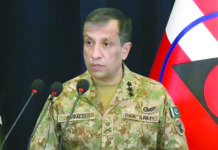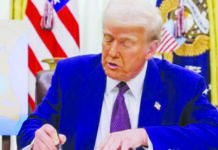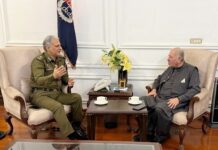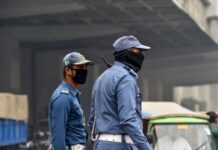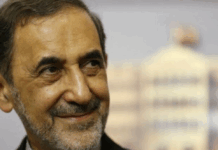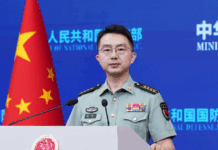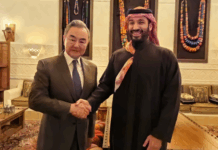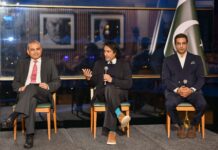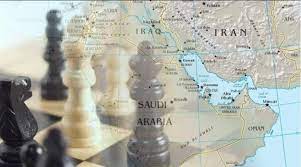Iran has departed from its traditionally balanced relationship between the East and the West and has instead embraced Russia and China. The withdrawal of the USA from the nuclear deal has left Iranian leaders pessimistic about any prospects for a relationship with Washington.
Initially, Tehran agreed to sign the Joint Comprehensive Plan of Action (JCPOA) with the Obama Administration, accepting substantial reductions in its nuclear programme in exchange for a significant lifting of US economic sanctions. Consistent with its long-standing goal of maintaining distance from Washington, Tehran was pleased that the JCPOA allowed it to avoid normalizing relations with its adversary while still benefiting economically from resumed oil exports and foreign investments.
However, after the US withdrawal from the nuclear deal, Iran concluded that Washington’s policy towards Tehran was unreliable, and that the US political class could not be influenced. The limited ability or willingness of European countries to defend the 2015 agreement further frustrated the Iranian leadership. Additionally, internal factors such as pressure from hardliners to strengthen the country’s military capabilities, economic weaknesses, and challenges to the continuity of the political system sparked intense debates on Iran’s foreign policy.
Although the Iranian foreign and defence policy bureaucracy had decided to reorient Iranian relations towards China and Russia as early as 2019, concrete steps in that direction were taken only during the administration of Hassan Rouhani in August. The Rouhani delegation’s deliberate delays during negotiations with the USA and the broader international community, aimed at potentially reviving the JCPOA, serve as a clear indication of this decision.
Since President Ibrahim Raisi’s inauguration on 5 August 2021, the eastward axis has assumed a more prominent role. Raisi’s presidency has brought coherence to the overall policy of the Iranian political system, with a focus on maintaining the status quo. This shift was necessary after Rouhani’s presidency, which saw somewhat liberal administrators surrounding the bureaucracy. Throughout the history of the Islamic Republic, Iran’s legislative and judicial branches have consistently demonstrated loyalty to the status quo. However, with each change of president, the executive branch has had the opportunity to fill approximately 11,000 administrative positions across the country with like-minded individuals.
Under the conservative Raisi government, the three branches are determined to maintain the current inertia and coherence of the Islamic Republic. Iran is now pursuing a two-pronged foreign policy approach: a strong shift towards Russia and China, while simultaneously making further concessions on its nuclear programme to create the impression that another deal is possible.
The implementation of the first approach is being done quietly, while the second approach is receiving wide publicity. Despite lacking support from the general public, particularly the educated and professional classes, Iran has persisted in its turn to the East. Discussions about the country’s foreign policy direction have been confined to the upper ruling class circles. However, three main reasons can be identified for Iran’s growing alliance with China and Russia.
Firstly, Iran has a longstanding policy of avoiding normalization with the USA due to concerns about the consequences it would have on the current political system, domestic politics, economy, and culture. The Iranian leadership fears that increased presence of US companies, academic institutions, and civil society organizations would erode their grip on power. Anti-US sentiment also serves to unite the revolutionary class and prevent more pragmatic or internationally-minded groups from gaining power.
Secondly, there is a belief among the Iranian revolutionary class that rapprochement with the USA would lead to significant and undesirable changes in the political system. They argue that concessions on the nuclear programme alone would be insufficient, and that Iran would eventually have to capitulate completely to the USA, reviving memories of the 1953 US-British coup. The revolutionary class, deeply involved in the political and economic arenas of the state, is unwilling to relinquish power or make structural concessions that could facilitate a liberal takeover.
Faced with an upcoming period of leadership transitions and successions, Tehran may feel comfortable relying on Moscow and Beijing for financial, political, and security support. However, the Iranian political establishment faces a significant challenge. The social and political environment that emerges as Iran’s third supreme leader consolidates power will determine the sustainability of this unbalanced geopolitical realignment.
Lastly, Iran has historically prioritized its national security over economic development. The reliance on energy exports has provided revenue to sustain the political system. Iran’s active foreign policy is primarily directed towards neighbouring and foreign countries, driven by its national security ideology and a strategy of expanding regional influence vis-à-vis major Arab states, Israel, and the USA. Turkey remains one of the few countries in the region with which Iran has maintained stable relations.
In recent years, Tehran has forged a military alliance with a significant external power, Russia. Moreover, Iran’s missile and drone capabilities, along with its geopolitical influence in the region, have served as an effective deterrent strategy. However, these notions of national security, threat perceptions, and statecraft leave little room for promoting economic growth in a globalized economy. This is in stark contrast to neighbouring countries such as Saudi Arabia, Turkey, Israel, and the United Arab Emirates, which have intentionally focused on economic diversification, high-tech industries, renewable energy, and attracting foreign direct investment (FDI). These countries concentrate their efforts on economic development while maintaining a balance between the West and the East, capitalizing on support from both Beijing and Moscow. They benefit from European and American financial and technology sectors, making substantial profits by selling in those markets.
In contrast, economic development is not a priority for Iranian leadership. Instead, Iran dedicates a significant portion of its resources to internal and national security. As a result, even a complete political and economic shift away from the West does not threaten Iranian state-owned companies or have a significant impact on them. Conversely, Western companies and banks have excluded Iran as a potential market due to US and European sanctions.
Consequently, Iran’s turn towards the East will likely reduce its economy to selling fossil fuels to China and other Asia-Pacific countries in exchange for imports of raw materials. However, these clients are unlikely to invest in Iranian industries due to the restrictions imposed by current sanctions. Thus, the only plausible investment opportunities for Iran may come in the form of barter, where Iran could export oil in exchange for infrastructure development without involving financial transactions.
The timing of Iran’s leadership decision to reduce political and economic dependence on the West, particularly Europe, is significant. The strategic choice was made at a high level to prevent dissenting views within the country. Iran’s deepening ties with Russia and China not only risk jeopardizing its foreign economic relations but also contribute to maintaining progress on its nuclear programme as a strategic component of its national security doctrine.
Moscow sees Iran’s anti-American sentiment as a highly valuable geostrategic asset. In a sense, Iran serves as the Belarus of southern Russia. Historically, Russia has consistently aimed to keep Iran out of the Western orbit, a policy that has spanned the Russian Empire, the USSR, and the current Russian Federation. Iran is set to receive 24 Su35 fighter jets and Russia’s S-400 air defence system, while Tehran has provided Moscow with low-cost drones and weapons systems.
Additionally, the two countries cooperate in the energy sector, with Russia reportedly supplying Iran with 30,000 tons of diesel fuel in early 2023. However, it remains uncertain whether Russia’s technological limitations in the energy sector will hinder the effective implementation of these plans. While military relations with Russia have expanded since the invasion of Ukraine, there are other motivations behind Iran’s desire to strengthen ties with Moscow.
Two main reasons stand out. Firstly, Tehran seeks access to classified information about US and Israeli operations against Iran. Secondly, Iran believes Moscow can provide political and intelligence support during the transition period for Iran’s third supreme leader. These expectations align with Russia’s fundamental interests regarding Iran and the West, regardless of whether Vladimir Putin remains in power.
Iran has reached a point where it can no longer rely solely on internal controls and regional deterrence to maintain the political system. Israel’s approach of establishing security partnerships with non-Arab countries has now extended to the South Caucasus and Central Asian regions. Furthermore, most of Iran’s Arab neighbours currently maintain diplomatic relations with Israel; thereby increasing US influence vis-à-vis Tehran.
Faced with limited foreign policy options, including the possibility of reinstating the JCPOA and diminishing prospects of reaching a modus vivendi with the United States in the context of Russia-Western relations, Iran seeks to secure its position in a changing regional landscape and safeguard the continuity of its political system. In this context, as long as Russia’s interests conflict with those of the West, Moscow is likely to exert considerable effort to protect the Islamic Republic of Iran. In contrast to Russia’s strategic calculations, China has primarily focused on political and trade relations with Iran. China has cautiously worked alongside the United States in the Middle East instead of opposing it. Beijing maintains significant short- and long-term business and technological interests in maintaining peace and cooperation with Israel, as well as major Arab countries like Saudi Arabia and the United Arab Emirates. Moreover, Iran’s oil imports are crucial for China’s global crude supply.
China’s mediating role between Iran and Saudi Arabia underscores how its positive relations with the Islamic Republic provide valuable political leverage in the region, serving its global rivalry with the United States. Unlike the USA and Europe, Russia and China do not concern themselves with Iran’s internal political system, constitutional structure, or governmental machinery.
Among Iran’s three main adversaries the USA, Israel, and Saudi Arabia – Iran recently recognized the likelihood of rapprochement with Saudi Arabia, marking a complete U-turn in March 2023 with the help of Chinese mediation. Iran’s decision to compromise with Saudi Arabia was influenced by various factors, including the political and financial role of Iranian minorities within Saudi Arabia, as well as Iranian opposition groups in Europe and the USA.
Iran apparently made concessions in exchange for reduced Saudi support for the Iranian opposition in Yemen. While Yemen holds little value compared to Lebanon, Iraq, and Syria in terms of Iran’s regional influence, the shift in Iranian policy demonstrates an effort to adapt to the evolving geopolitical landscape.
The current direction of Iran’s foreign policy not only contradicts Beijing’s or Moscow’s overall international outlook but also aligns with their interests in their tense relationship with the USA. By aligning with Russia and China in security and trade, Iran believes it has secured insurance against any potential adverse UN Security Council resolutions.
Additionally, faced with an upcoming period of leadership transitions and successions, Tehran may feel comfortable relying on Moscow and Beijing for financial, political, and security support. However, the Iranian political establishment faces a significant challenge. The social and political environment that emerges as Iran’s third supreme leader consolidates power will determine the sustainability of this unbalanced geopolitical realignment.


